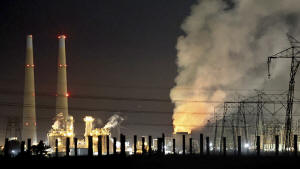Smoke from fire at California lithium battery plant raises concerns
about air quality
 Send a link to a friend
Send a link to a friend
 [January 18, 2025]
By OLGA R. RODRIGUEZ and ISABELLA O'MALLEY [January 18, 2025]
By OLGA R. RODRIGUEZ and ISABELLA O'MALLEY
SAN FRANCISCO (AP) — A fire at the world’s largest battery storage plant
in Northern California smoldered Friday after sending plumes of toxic
smoke into the atmosphere, leading to the evacuation of up to 1,500
people. The blaze also shook up the young battery storage industry.
The fire at the Vistra Energy lithium battery plant in Moss Landing
generated huge flames and significant amounts of smoke Thursday but had
diminished significantly by Friday, Fire Chief Joel Mendoza of the North
County Fire Protection District of Monterey County said. Vistra is based
in Texas.
“There’s very little, if any, of a plume emitting from that building,”
Mendoza said. Crews are not engaging with the fire and are waiting for
it to burn out, he said. Letting lithium-ion battery fires burn out is
not unusual because they burn very hot and are hard to put out.
No injuries have been reported but residents raised concerns about
hazardous gases being released into the air.
The fallout from the fire at the battery storage facility about 100
miles (160 kilometers) south of San Francisco was just beginning.
“This is more than a fire, this a wake-up call for the industry. If
we’re going to be moving ahead with sustainable energy, we need to have
a safe battery system in place,” Monterey County Supervisor Glenn Church
said at a Friday morning briefing.

Battery storage is considered crucial for feeding clean electricity onto
the grid when the sun is not shining or the wind is not blowing, and it
has been used in significant amounts only in the last couple of years.
But the batteries are nearly all lithium, which has a tendency toward
“thermal runaway,” meaning it can catch fire and burn very hot,
releasing toxic gases.
Vistra sells energy to Pacific Gas & Electric, one of the nation’s
largest utilities.
The blaze did not spread beyond the facility, according to Monterey
County spokesperson Nicholas Pasculli. Evacuation orders for from 1,200
to 1,500 people were lifted Friday evening after officials confirmed
there was “no threat to human health,” the Monterey County Sheriff’s
Office said in a statement. But residents were advised to close their
windows and turn off their air conditioning.
“There’s no way to sugar coat it. This is a disaster,” Monterey County
Supervisor Glenn Church told KSBW-TV.
Brad Watson, Vistra’s senior director of community affairs, said the
Environmental Protection Agency is testing air quality at the facility
and that the company has hired an air consultant to check for pollution
in nearby communities. Vistra will share the results when they are
available, Watson said.
Kelsey Scanlon, director of Monterey County’s Department of Emergency
Management, told reporters that the release of hydrogen fluoride into
the atmosphere from the blaze is a cause for concern.
The Centers for Disease Control and Prevention says hydrogen fluoride
gas can irritate the eyes, mouth, throat, lungs and nose, and that too
much exposure to the gas can be deadly.

[to top of second column]
|

Flames and smoke from a fire fill the sky at the Moss Landing Power
Plant Thursday Jan. 16, 2025 in Moss Landing, Calif. (Shmuel Thaler
/The Santa Cruz Sentinel via AP)

Residents expressed concerns about air quality during an emergency
meeting of the Monterey County Board of Supervisors earlier Friday.
“It doesn’t appear that the fire department had the appropriate fire
retardants to minimize this fire and have to resort to actually
letting it burn, exposing all of the residents, including
Watsonville in Santa Cruz County, and this is extremely disturbing,”
resident Silvia Morales said.
Monterey County Sheriff Tina Nieto said air quality monitoring
systems had not detected any hazardous gases in the air.
Watson said two “overheating events” happened at the battery plant
in 2021 and 2022 because the batteries got wet. A third incident
happened in 2022 in the neighboring Elkhorn battery plant that is
owned by PG&E, he said.
Lithium batteries make the power grid more stable and reduce the
need for energy to be generated from fossil fuels, which release
planet-warming gases. California was an early adopter of battery
storage and leads the nation with more than 11 gigawatts of
utility-scale storage online, which can meet nearly half of the
demand on the state's main grid for four hours per day.
Experts say lithium batteries are a safe technology that are
essential for lowering carbon emissions and making grids more
reliable. But they are a significant fire risk if they are damaged
or overheat.
“We are not convinced that this incident could materially shift the
national trend of growing grid scale battery deployment,” said
Timothy Fox, managing director of ClearView Energy Partners, a
non-partisan energy research firm.
It was unclear what caused this latest fire. Vistra said in a
statement that after it was detected, everyone at the site was
evacuated safely. After the fire is out, an investigation will
begin.
“Our top priority is the safety of the community and our personnel,
and Vistra deeply appreciates the continued assistance of our local
emergency responders,” Jenny Lyon, a spokesperson for Vistra, said
in a statement.
Jodie Lutkenhaus, professor of chemical engineering at Texas A&M
University, said safer batteries must be found that can be used on
the grid.

Some improvements, such as more fire prevention measures, can be
made to reduce fire risks with lithium batteries, Lutkenhaus said,
“but the only way to really address the problem is to use a safer
technology.” Water-based and redox flow batteries are being
developed by scientists but have not yet scaled commercially.
Lithium iron phosphate batteries are a possible alternative because
they are highly stable, but they still carry some fire risk.
No matter what kind of lithium battery you use, "when you reach a
certain size, it is inherently very dangerous and easy to catch
fire,” said Yiguang Ju, engineering professor at Princeton
University.
___
O'Malley reported from Philadelphia.
All contents © copyright 2025 Associated Press. All rights reserved |